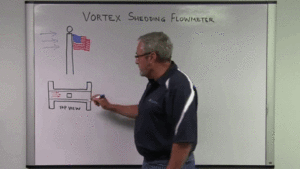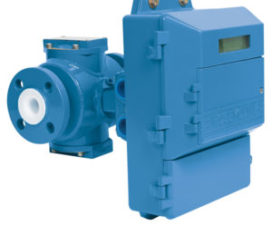You know what vortex flow meters do, but have you ever wondered how they work? Let’s dive right in, starting with a little history.
Kármán’s Vortex Street
In 1911, Theodore von Kármán, a modern engineer and mathematician, discovered that if a fluid passes a buff body with enough velocity, it will create high and low pressure zones downstream, and as a result, form vortices. The phenomenon is now known as Kármán’s Vortex Street.
Kármán used his observation to explain the collapse of the Tacoma Narrows Bridge in 1940, as you can see in the famous footage here.
Another real-life example of this is how a flag flaps in the wind. When the fluid (air) flows past a bluff body (the flagpole), the resulting high and low pressure zones cause the flag to wave.

Vortex flow meters
Kármán’s principle can be used in to explain how today’s vortex flow meters operate.
When your process fluid flows around a shedder bar (the bluff body), it creates low and high area pressure areas — or alternating high and low vortices — downstream (a vortex street).

Shedder bars are generally equipped with two piezoelectric crystals. When the shedder bar moves back and forth with the alternating pressure zones headed downstream, the crystals are pinched within the pipeline. This creates an alternating change in frequency that can be registered, amplified, and communicated using a transmitter.
Here are a few more things to keep in mind about flow meters:
- Can only be used with clean, non-erosive fluids with a high flow rate
- Typical applications are liquid, gas, and steam
- Range in size anywhere from ½” to upwards of 10”
And the benefits of using a vortex flow meter include:
- Low-maintenance
- No moving parts
- Cost-effective
Watch the full explanation video below.
If you need assistance figuring out if a flow meter will work for your application or sizing your instruments, give us a call at (314) 665-1741.

